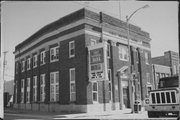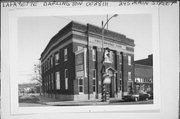Property Record
245 MAIN ST
Architecture and History Inventory
| Historic Name: | First National Bank |
|---|---|
| Other Name: | First National Bank |
| Contributing: | Yes |
| Reference Number: | 28111 |
| Location (Address): | 245 MAIN ST |
|---|---|
| County: | Lafayette |
| City: | Darlington |
| Township/Village: | |
| Unincorporated Community: | |
| Town: | |
| Range: | |
| Direction: | |
| Section: | |
| Quarter Section: | |
| Quarter/Quarter Section: |
| Year Built: | 1921 |
|---|---|
| Additions: | 1986 |
| Survey Date: | 1982 |
| Historic Use: | bank/financial institution |
| Architectural Style: | Neoclassical/Beaux Arts |
| Structural System: | |
| Wall Material: | Brick |
| Architect: | |
| Other Buildings On Site: | |
| Demolished?: | No |
| Demolished Date: |
| National/State Register Listing Name: | Main Street Historic District |
|---|---|
| National Register Listing Date: | 10/7/1994 |
| State Register Listing Date: | 7/15/1994 |
| National Register Multiple Property Name: |
| Additional Information: | A 'site file' exists for this property. It contains additional information such as correspondence, newspaper clippings, or historical information. It is a public record and may be viewed in person at the Wisconsin Historical Society, State Historic Preservation Office. This tile and brick faced symmetrically designed, two-story bank building has a flat, three bay section topped by an entablature and an attic story projecting from the main five bay facade, visually suggesting a portico for the building. A pedimented door hood supported by columns is over the entrance door and transom. The words "First National Bank" are inscribed into the frieze of the protruding central facade. Plain belt courses accent the top of the building, the traditional cornice line and the base of the building. A line of brick piers identical to those at the front visual support the entablature along the north side of the structure, curving to conform to the street pattern along the railroad tracks (now non-functional). This bank building is architecturally significant as a good vernacular, scaled-down interpretation of the early 20th century neo-classical Revival that has retained its historical character. In addition, it is significant to the community because it occupies a key site in the commercial district. The First National Bank is historically significant as the first monetary institution in Lafayette County. Secondly, it is significant to the development of Darlington's commercial district. The First National Bank is the oldest monetary institution Lafayette county.(B) The bank was established in September 1866 by Julius Rogers, James Judge and E. M. Fitch. Originally it was called the Lafayette County Bank and located in a building on the site of the present Citizens National Bank (LT 5-14). In February 1869, Rogers disposed of his controlling interest and retired. The new firm was known as fitch, Judge and Co. In 1869 J. B. Doty purchased control and reorganized the bank, and operated under the name Doty, Fitch and Co. Later on Fitch moved to Chicago and on January 1, 1873, George S. Anthony became a partner with Judge selling out. J. B. Doty was succeeded by P. A. Orton and Co. Orton and his law partner and associate in the bank were prominent attorneys in Lafayette Co. In 1878 the firm sold one-half interest to D. B. and J. E. Otis and the firm became Orton, Otis and Co. The bank completed a new building in 1874 and moved there (now Republican Journal building).(B) The Lafayette County Bank was reorganized as a First National Bank in May 1884.(C) P. A. Orton remained president of the firm until his death in June 1919.(D) Orton's son Robert was vice-president and later became president of the bank.(C) In 1921 this building was erected and the bank moved to its new quarters.(A) In August 1917, a fire had destroyed the entire 200 block on the east side of Main Street. Many of the buildings were replaced within the next five years.(F) The bank was erected in 1921. Always this corner had been occupied by a large hotel which catered to the visitors who had arrived in Darlington by railroad. Perhaps by 1921 the days of railroad travel and large htoels were nearly gone and a new use for the corner became apparent. |
|---|---|
| Bibliographic References: | Sanborn-Perris Map, Darlington, 1924. C.W. Butterfield, "History of Lafayette County," 1881, p. 544. "Darlington Republican Journal," June 26, 1919. "Wisconsin Necrology," Vol. 21, pp. 201-202. Julius Bleyer, "Free Masonry in Wisconsin," 1900, pp. 131-132. "Republican Journal," September 13, 1917. |
| Wisconsin Architecture and History Inventory, State Historic Preservation Office, Wisconsin Historical Society, Madison, Wisconsin |



